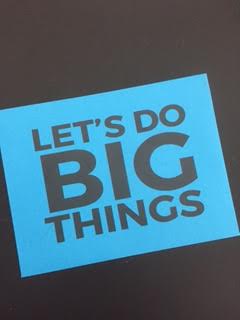How Understanding Your A B C’s is the first Step To Driving sales growth …

As leaders of sales teams what do we all have in common? We all want to have our team hit their sales numbers and we want to insure our teams are working the sales process to insure they are creating sales velocity. However when we travel with sales people making sales calls it often becomes apparent they need help prioritizing their time to insure the sales plan is met and or exceeded. One of the best ways to increase sales today while filling the sales pipeline is helping your salespeople understand their A B C’s.
I remember working with a salesperson and we were out making four legged sales calls. My goal was to mirror this guys for a few days to determine how he spends his time, what he feels his job is and how that compares to the companies expectation and overall assess why we can’t seem to open net new customers in his region. Here is what I observed;
- we called on accounts who were already customers and they were all very happy
- the accounts we visited with included one large customer and a number of small customers
- we did not call on any new accounts ( although we drove by a number of them as we worked his bread route)
- the salesman was excellent in what I refer to as the “no smoke and mirrors approach”
- I asked how many accounts he had in his area of responsibility and at first he was not sure , but later said “ I think I have around 1500 customers”
On the one hand, if our time together was any indication of how all his customers feel, he probably has a number of very happy customers who value his approach and experience. I asked him how he can serve so many accounts. And he quickly replied “it’s really hard but they love me because I treat everyone the same…big or small I give them all the same amount of attention and I think that’s why they are loyal to me.” However it quickly became apparent why this region was basically flat in sales and not opening net new customers: this rep did not know his A B C’s.
Let’s take a little deeper dive into this situation.
In reality he had 986 customers, and was not touching all of them every year
Average number of work days in a year: 251
Holidays, vacation days, sick days: Approximately 30
So this salesman has approximately 221 days to see 986 customers
To just see his current customers once per year he would need to see 4-5 per day, every day without any extracurricular activities (ECA’s) getting in the way (and that’s a whole other blog post waiting to happen)
In addition part of his responsibility is to reach out to 2-3 net new customers per week, but we discovered that was just not happening.
My next step was to work with the VP of sales and shared my findings and wanted his feedback. He said he never looked at his sales regions like this before and wanted to know what I would do. Very quickly I said we will establish A B C’s for this region.
A Account
This is a list of top producing revenue accounts you currently have in a region who you suspect will be buying more products and services from you. Most people sort it by sales history descending, and often add accounts that you are currently selling, but could be buying quite a bit more with some attention. I always add new target accounts in the market you are not selling but have similar characteristics to accounts you serve today and probably have similar problems like those you solve for your current accounts every day.
B Accounts
These accounts are in the middle of the road, revenue wise, accounts that you have sold, continue to sell, but you do not see a huge sales growth potential in. You obviously value their business and you want to insure they are happy and continue to be loyal to your company. If one of these accounts grows and they often do, you want to be there when they become an A account. If this list is not too large I may add other new account targets, often based on proximity to current customers, but would not be considered to be one of your core markets.
C Accounts
These are the smaller accounts revenue wise but often take the greatest amount of your salespeople’s time. When something goes wrong with this customer type all hell brakes lose and they expect your salesperson to drop everything and help them. They may have once been large accounts who now only buy small amounts due to downsizing or some other shift in their business. These may be small mom and pop customers who again you want to serve and make happy fans, but their overall future sales opportunity is limited.
I usually have everyone agreeing to this point and then everyone’s mood changes with the next question….
What is the best way, from the customer’s needs perspective, to serve them?
This is where the sales guys immediately get nervous and argumentative. In reality they are not arguing with what I am about to say, but more with what they perceive the personal impact will be in their compensation. Sometimes I have sales VP agree up to this point but fail to execute any changes because it feels like a lot of work sorting through accounts. If you have been in your market for more than 10 years it could be a large undertaking. So I share a quick way I have used that is not too scientific but results in the desired new customers and sales growth we are looking for.
A B C Account segmentation according to Mark:
- Print the salesperson’s account list , sorted by customer in sales descending
- Draw a line about 1/3 of the way down through the list of accounts
- Everyone below the line is now a C account
- In the 1/3 of accounts above the line, draw a line ½ way through this number of accounts
- everyone above this new line is now an A account and everyone below the new line, but above the 1/3 line is a B account
- Gut check step – sales VP and salesperson review B and C accounts and make sure none should be A’s based on opportunity, if so add them to A list
Let’s get back to the salesperson I was working with…so out of 986 customers (who he really was only touching about 400 per year anyway) now 740 are considered C accounts and 123 are now A accounts and 123 are B accounts.
How do we work our A B C’s?
A Accounts
These accounts will be seen frequently to add the most value without being counterproductive to the sales process. In this market we identified over 60 new target accounts in this companies’ market, sweet spot that are like those they sell, but do not sell today. So on our example this rep now has 193 key accounts that can drive his sales objectives.
B Accounts
We will establish a call pattern that best serves this customer base and it is often 1-2 face to face meetings per year and quarterly calls and monthly emails. This rep has 123 B accounts.
C Accounts
All C accounts will be served by inside sales customer service and not field sales. They will use email, phone calls and direct mail to keep in touch with these smaller accounts and actually provide a better overall buying experience than what they were receiving.
When I applied this model to one of my sales teams that was struggling with net new customers and selling new products at current customers we realized the following;
- we achieved new product sales objectives
- exceeded our sales plan numbers
- We achieved new customer acquisition targets
- Our C accounts grew, 115% to prior sales within 90 days of implementation and in the following year grew over 146%
- My field sales people made more commissions and were less stressed
- Billing errors decreased
- Overall customer satisfaction in all categories increased
- Our account attrition decreased
Helping your sales team understand their markets A B C’s is one of the quickest ways to insure your sales plan is met and exceeded.
How do you segment and align your accounts for your sales people?
How do you transition accounts from inside sales to field sales?
How often do you transition accounts from B to C status?
Have you segmented your sales rep’s market and if so what results did you realize?
Helping your reps understand their A B C’s improves focus. This also will provide the time and incentive to pursue those accounts your owner always seems to drive by and then you get an email or phone call; “Why aren’t we selling these guys?”








